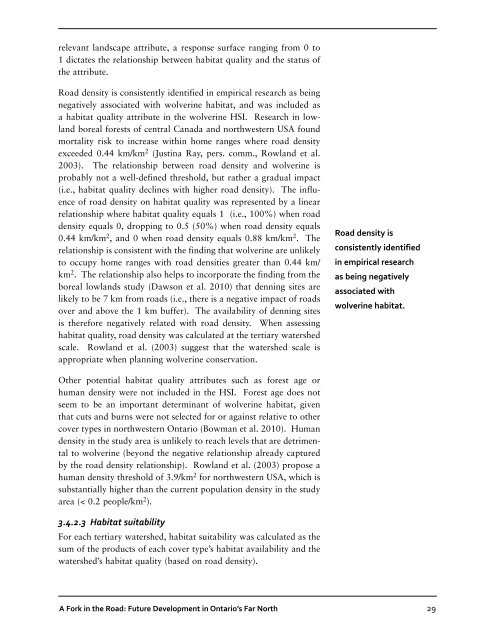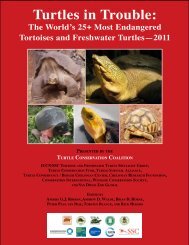Create successful ePaper yourself
Turn your PDF publications into a flip-book with our unique Google optimized e-Paper software.
elevant landscape attribute, a response surface ranging from 0 to<br />
1 dictates the relationship between habitat quality and the status of<br />
the attribute.<br />
Road density is consistently identified in empirical research as being<br />
negatively associated with wolverine habitat, and was included as<br />
a habitat quality attribute in the wolverine HSI. Research in lowland<br />
boreal forests of central <strong>Canada</strong> and northwestern USA found<br />
mortality risk to increase within home ranges where road density<br />
exceeded 0.44 km/km 2 (Justina Ray, pers. comm., Rowland et al.<br />
2003). The relationship between road density and wolverine is<br />
probably not a well-defined threshold, but rather a gradual impact<br />
(i.e., habitat quality declines with higher road density). The influence<br />
of road density on habitat quality was represented by a linear<br />
relationship where habitat quality equals 1 (i.e., 100%) when road<br />
density equals 0, dropping to 0.5 (50%) when road density equals<br />
0.44 km/km 2 , and 0 when road density equals 0.88 km/km 2 . The<br />
relationship is consistent with the finding that wolverine are unlikely<br />
to occupy home ranges with road densities greater than 0.44 km/<br />
km 2 . The relationship also helps to incorporate the finding from the<br />
boreal lowlands study (Dawson et al. 2010) that denning sites are<br />
likely to be 7 km from roads (i.e., there is a negative impact of roads<br />
over and above the 1 km buffer). The availability of denning sites<br />
is therefore negatively related with road density. When assessing<br />
habitat quality, road density was calculated at the tertiary watershed<br />
scale. Rowland et al. (2003) suggest that the watershed scale is<br />
appropriate when planning wolverine conservation.<br />
Road density is<br />
consistently identified<br />
in empirical research<br />
as being negatively<br />
associated with<br />
wolverine habitat.<br />
Other potential habitat quality attributes such as forest age or<br />
human density were not included in the HSI. Forest age does not<br />
seem to be an important determinant of wolverine habitat, given<br />
that cuts and burns were not selected for or against relative to other<br />
cover types in northwestern Ontario (Bowman et al. 2010). Human<br />
density in the study area is unlikely to reach levels that are detrimental<br />
to wolverine (beyond the negative relationship already captured<br />
by the road density relationship). Rowland et al. (2003) propose a<br />
human density threshold of 3.9/km 2 for northwestern USA, which is<br />
substantially higher than the current population density in the study<br />
area (< 0.2 people/km 2 ).<br />
3.4.2.3 Habitat suitability<br />
For each tertiary watershed, habitat suitability was calculated as the<br />
sum of the products of each cover type’s habitat availability and the<br />
watershed’s habitat quality (based on road density).<br />
A Fork in the Road: Future Development in Ontario’s Far North<br />
29







![RaLand / SeaScape [PDF] - Wildlife Conservation Society](https://img.yumpu.com/49974326/1/190x245/raland-seascape-pdf-wildlife-conservation-society.jpg?quality=85)









